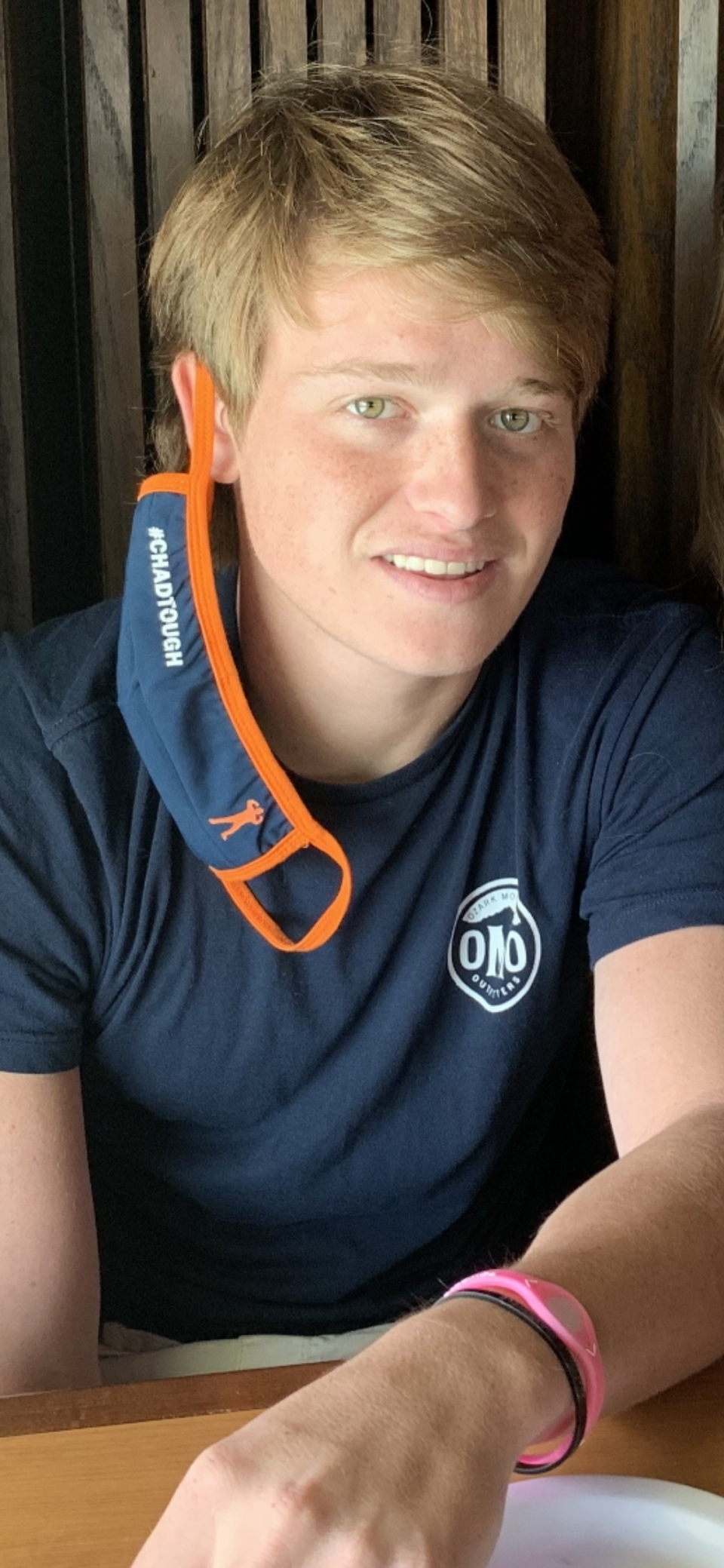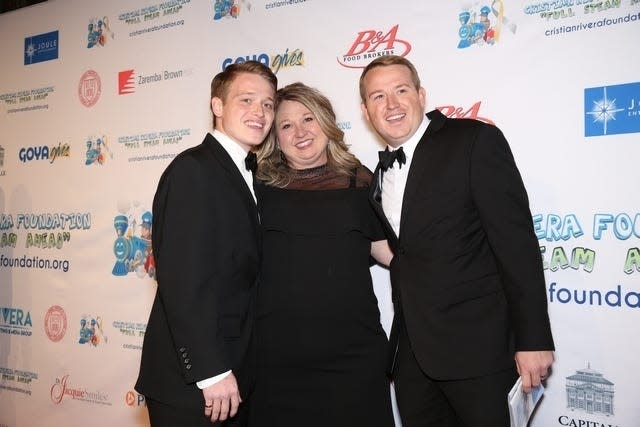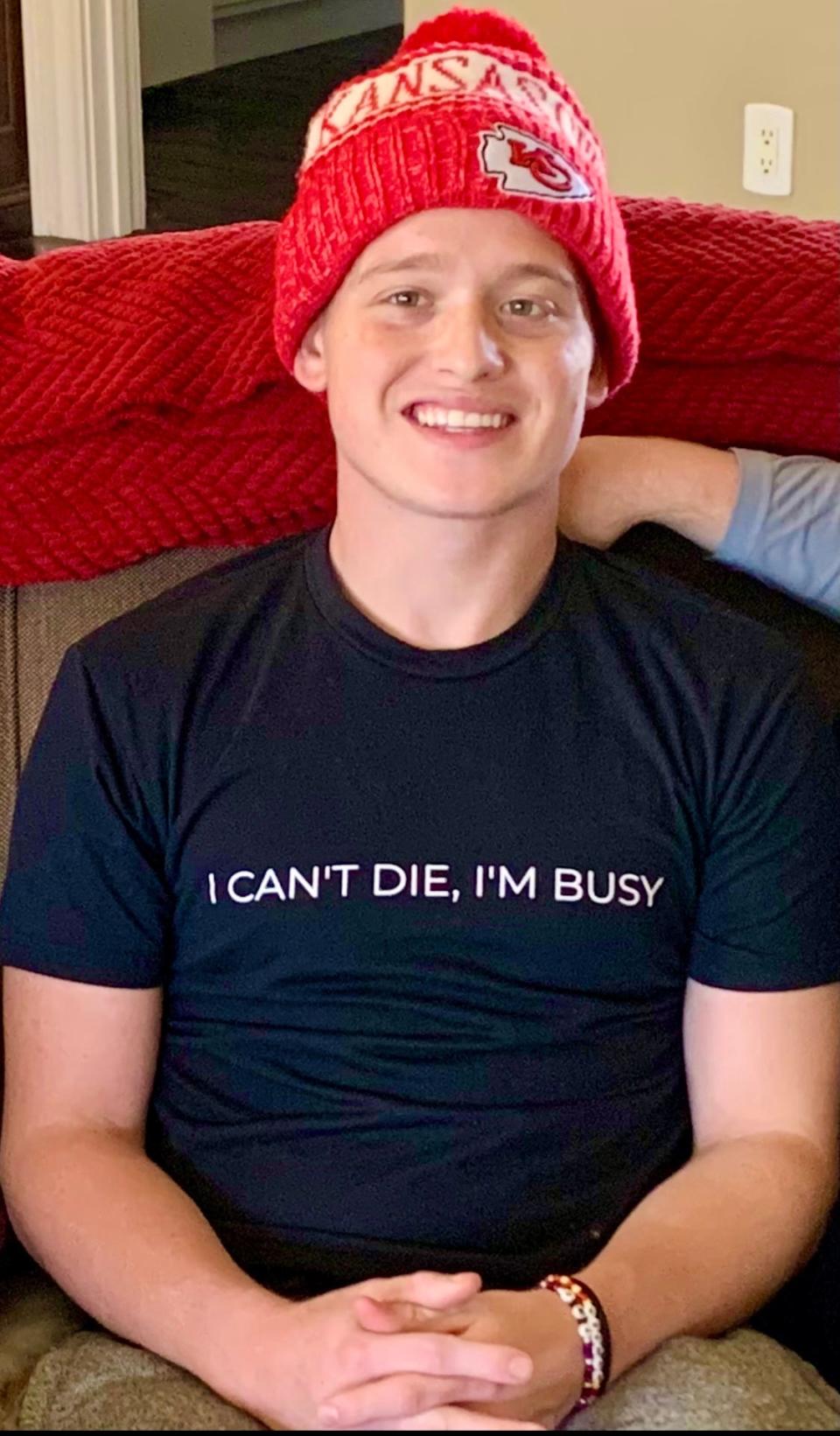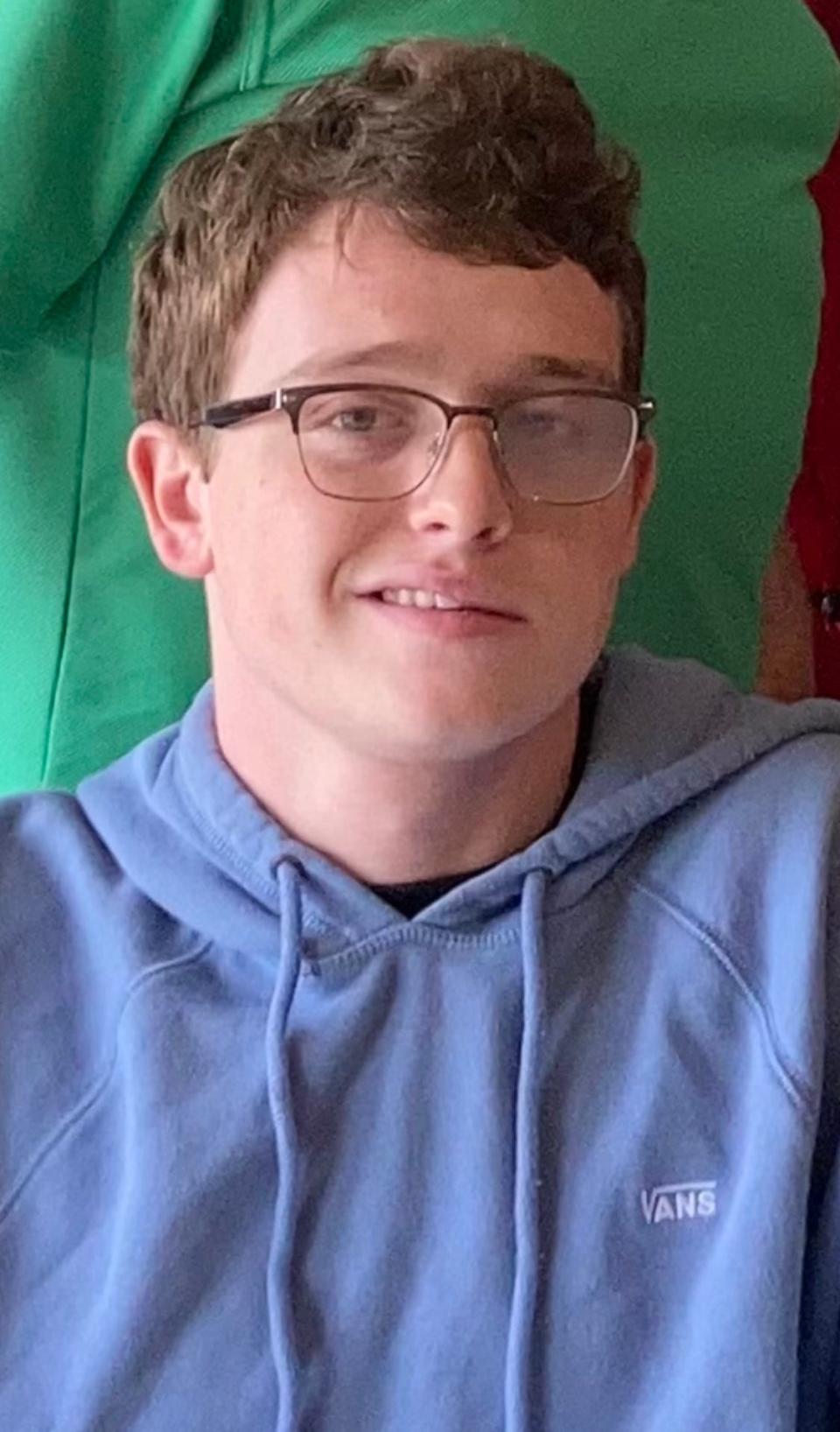'I can't die. I'm busy': Brain cancer patient and his mom save lives by pushing care in new ways
Lisa Ward's son Jace has been gone for a year. But his impact on the care of children with brain cancer continues. Lisa makes sure of that.
Jace, of Wamego, Kansas, was 20 and a sophomore at Kansas State University when he was diagnosed with diffuse intrinsic pontine glioma, DIPG, a particularly aggressive form of brain cancer that usually strikes younger children. Affecting about 300 Americans a year, DIPG spreads its tentacles through the brainstem where functions such as breathing and movement are controlled.
The neurologist who diagnosed Jace said he probably had six to nine months to live.
"I'm not afraid to die," Lisa remembers Jace saying. "I'm afraid to not have enough impact before I do."
Though many people look for a mission in life or a sign that they're doing the right thing, once he understood the battle he was fighting, Jace had a clear vision for himself.
Being far older than most DIPG patients, Jace could communicate with doctors in a way that provided them with insights about his experience with treatments. Between that, his dynamic personality and a growing sense of purpose, he sought to transform DIPG's treatment, which hadn't changed since astronaut Neil Armstrong's daughter died of the disease in 1962.
“Probably every day somewhere in the world, someone calls me and says, ‘I want you to know my child had a better chance because we followed what Jace did,’” said Lisa, who with her husband, Roger, an electrician, has two older children, Blake and Brooke.
Jace didn't dwell on his prognosis. He figured he was living on borrowed time. The double-vision that was his first symptom began six weeks after a car accident that could have been fatal.
"I can't die. I'm busy," he'd say.
"This became his mantra," Lisa said.
And he lived up to it.
Jace traveled to Washington and took the stage at fundraisers to build awareness about DIPG and lobby for more money for pediatric brain tumor research. He fought the traditional boundaries that kept fundraising groups separate and researchers in their silos, believing more would be accomplished by collaborating.
"His charisma was totally stunning," said Reed Jobs, who first met Jace on a Zoom call a few months after his diagnosis. Jobs, whose father, Steve, famously co-founded Apple and died of pancreatic cancer, hired Jace as an intern at Emerson Collective, a philanthropy-focused company where Jobs serves as managing director of health. "Carrying on his mantra of urgency and patient focus is one of the best lessons he ever taught me."

As a digital native, Jace intuitively understood the benefits that could come from the free flow of medical data, said Adam Resnick, who directs the Center for Data-Driven Discovery in Biomedicine at Children’s Hospital of Philadelphia.
"Rather than wait for the normal course of things to take shape, they're pushing the limits of data generation and care that accelerates the process," Resnick said of Jace and Lisa.
The pair insisted patients get access to and share their data, so researchers could learn from it and use it to help the next patient, Resnick said. They demanded speed, so children wouldn't die while waiting.
"They have been and they are such a force of change," Resnick said, and this shift in thinking has been crucial for DIPG, for which there is no proven, effective care, and has implications for other diseases. "That's the narrative and his legacy in a way that should become a model for all pediatric brain tumors and pediatrics as a whole."
Transforming treatment
In mid-2019 when Jace was diagnosed with DIPG, patients didn't get their tumors biopsied. They were going to die anyway, so why subject them to brain surgery?
Jace and Lisa realized that a brain biopsy could provide useful information, both to guide an individual's treatment and to compare how that patient fares with others whose biology or care is similar.
That way, Resnick said, others could learn from each patient's experience.
Jace got a biopsy, which helped guide his treatment. He donated the tissue to Stanford University and the Children's Brain Tumor Network, a consortium of 30 institutions, run out of Resnick's hospital.
Jace became among the first DIPG patients to turn down massive doses of steroids. Although steroids had been the standard therapy for decades, reducing inflammation and some symptoms, studies show they don't improve long-term outcomes in DIPG. They do lead to tremendous weight gain, angry emotions, weak immunity and loss of balance.
"He was vain and didn't want to change his looks," Lisa said. Jace proved the same symptoms could be treated other ways. Last fall, a group of experts agreed and changed the standard treatment for DIPG to move away from prescribing steroids proactively.
A few months after his diagnosis and radiation treatment, doctors suggested Jace join a trial for a drug called ONC201. He began lobbying Chimerix, a biotechnology company in Durham, North Carolina, to make it available to every DIPG patient – an opportunity more than 400 others have since taken. When there was wasn't enough money to pay for all those kids' ONC201, Jace and Lisa, through their fundraising arm Tough2gether Against DIPG, along with two other organizations, raised more than $1 million to give them access.

Research funding is a major issue for DIPG, which received about $2 million from the government the year Jace was diagnosed. With his help, that annual figure has doubled. Some of the money Lisa raises goes toward burial funds for kids whose families can't afford the cost.
Jace and Lisa's efforts provide hope to other families, said Laura Eicher, whose son Cole survived a different form of brain cancer and who serves as a manager with the American Cancer Society's Senior Childhood Cancer Initiatives.
Lisa knows all the things a family can do to fight their child's cancer, so she can tell them what comes next and when they've done everything possible, Eicher said.
"Imagine how wonderful that feels," she said. "Then you can spend more time on your child."
Using his voice for others
Turning 21 in February 2020, Jace decided to have a big birthday bash. He put the word out on Instagram, expecting about 100 friends. More than 500 showed up in his town, population 4,800.
ONC201 stabilized Jace's tumor for about a year, but in July 2020, his double vision worsened. The left side of his face began to droop.
The pons, the part of the brainstem where DIPG tumors are located, controls facial muscles as well as limbs on the opposite side. Jace couldn't control his right hand or arm and struggled to walk without stumbling. He couldn't play basketball anymore.
"As the spiderweb (of the tumor) builds, kids lose more and more function," Lisa said.
Jace invited seven of the country's top DIPG experts to a Zoom meeting to discuss next steps. Lisa didn't think they'd come, but they did. He'd met them through his fundraising and public speaking, and they were eager to help.
"What would you do if I were your kid?" Jace asked them.
Jace pushed to make a similar tumor board available to every child with a brainstem tumor. Lisa made it happen, bringing together 60 foundations to fund the effort. "If I had more time, it'd probably be 90," Lisa said. This month, eight doctors will start hearing 10 patient cases a week.
Taking his own tumor board's advice, Jace volunteered to become patient No. 2 in a clinical trial at Stanford University.
Researchers were trying to use the immune system to help control DIPG. They'd shown their approach was effective in mice, but they didn't know what would happen in people.
The biggest concern was that the infusion of Jace's own reengineered immune cells might be too much for his brain, leading to sudden death.
Jace volunteered anyway. "It's the only thing that could possibly cure me," he told his mother. "I don't want this slow, loss-of-function, loss-of-my-body death."
Jace wouldn't sign the consent form agreeing to keep quiet about the treatment. He wanted to be free to tell everyone in the DIPG community about his experience. "I'm doing this because I want to make this easier on other parents, and I have every right to share my story," he told them.
At Stanford, a quote from Jace hangs on the wall: "I’m gifting you my greatest asset," it reads, referencing his brain tissue donation. "Use it. Share it. Share everything you learn from it. If you don’t, I’ll haunt you."
The researchers who led the trial get choked up when thinking about Jace.
"We loved this patient," said Michelle Monje, a neuro-oncologist.
"An inspirational young man," added Dr. Crystal Mackall, founding director of the Stanford Center for Cancer Cell Therapy.
"He knew his voice was strong enough for those who couldn't speak," concluded Sneha Ramakrishna, a pediatric oncologist. "It was beautiful to see how much he wanted to use his voice for others."

Doing 'what's right' to save lives
Another focus for Lisa over the past year has been making sure children's brain tumors are genetically sequenced and the data is made available to everyone. Understanding the genetics behind the disease could help predict a patient's course and ideally lead to lifesaving treatments.
Scientists had sequenced 87 brainstem tumors, but 400 more sat in freezers. Under the funding available, sequencing them all would take three years – equal, Jace noted, to six times the life expectancy of a child with DIPG.
Corrie Painter, at the Broad Institute in Cambridge, Massachusetts, which conducted the sequencing, said she and others were inspired by Jace's insistence that their work was meaningful to patients.
The message she heard from Jace and Lisa was "Lay down all your petty reasons for not collaborating and sharing data and get it done before we all die," said Painter, associate director of the institute's Count Me In cancer patient initiative. "This is somebody who is in the thick of it, begging us to get over the traditional academic hang-ups and do what's right."
Jace's first immunotherapy treatment, in September 2020, was rough. He lost his lush, dirty blond hair from the chemotherapy needed to clear out his immune cells. But he got three nearly symptom-free months.
Jace asked Lisa, "Mom, what's going to happen if I get bad?"
"I'm going to be right beside you," she promised.
He wasn't worried about himself, he told her, but about what other DIPG families would do if he and Lisa weren't available to offer them guidance.
He wanted to set up a more structured system under which nurses could help parents navigate to the best centers and trials for them.
"He's in bed in the hospital telling me what to type," Lisa said. With help from others, she hired three nurses to run the MyDIPGNavigator.org program, which rolled out the week of May 17 – National DIPG Awareness Day and the third anniversary of Jace's diagnosis.
Taking risks
Jace was always an independent thinker and a risk-taker.
In high school, struggling to make it to first period, Jace missed his entrepreneurship class so often, the teacher warned him he was going to fail.
"You're teaching us to make our own way," Jace reminded him, then offered a deal: He'd enter an entrepreneurship competition. If he won, he'd get an A in the class; if he didn't, he'd get an F.
Jace won the statewide youth entrepreneurs competition, which earned his teacher "teacher of the year."
In late 2020, Jace developed a cyst in his brain, a clump of dead tissue that grew bigger as fluid accumulated. It triggered lockjaw, which meant he couldn't talk or eat his favorite foods – pizza and hamburgers.
Doctors installed an Ommaya reservoir, a small shunt placed under his scalp to drain the fluid.
Researchers were able to access tumor cells from that fluid and grow them in a lab to better understand his cancer.
The port allowed them to deliver immune cells directly into Jace's brain rather than throughout his whole body, reducing symptoms. The same kind of port eliminated the need for patients to get chemotherapy before immunotherapy – avoiding hair loss and other symptoms. It's become the standard approach for delivering DIPG immunotherapy.
In early January 2021, as symptoms returned, his doctors won federal approval to treat him again. Jace would be just the second patient to receive a second dose of his own reengineered immune cells.

The second treatment gave him vicious side effects. Full-body tremors. A rash. He spiked a fever of 106. Fluid had to be drained from his brain.
Researchers learned from his experience to add the immunosuppressive drug anakinra before the therapy rather than after. Jace never suffered as much again. Nor did the other patients in the trial.
Three weeks after his treatment, Jace attended Super Bowl 2021 in Tampa, Florida. When he'd entered the hospital in January, he couldn't walk farther than across the room. The therapy made such a difference that in Tampa, he walked 4 miles a day.
But the grace period between treatments was getting shorter. By March 23, 2021, it was time for another round of immunotherapy. His fourth treatment took place in late May, and he didn't leave the hospital before his fifth treatment on June 14.
Jace planned another big party for July 3. The Fourth of July was his favorite holiday. Tiny Wamego, Kansas, has celebrated the nation's independence in a big way for 150 years, Lisa said. In addition to a parade, for more than 35 years, the town has held one of the largest fireworks displays in the Midwest. Its population swells to 80,000 for the day.
Jace and his family returned from his treatment in California on June 30. He had dinner with his sister Brooke and some friends. That night, a friend who was staying over woke Lisa and said something wasn't right with Jace.
After rushing to the hospital in Topeka, Jace was flown to St. Louis where an MRI showed a blood vessel had burst in his brain. It might have been the tumor pressing on a vessel or the treatment inflaming his brain that caused the damage.
For a few days, unable to speak, Jace spelled out words by squeezing his hand. He got frustrated when his dad couldn't spell fast enough.
"What's so cruel about this tumor type is they are cognitively so aware of everything," Lisa said. "He was just trapped."
On the morning of July 3, Corrie Painter from the Broad Institute called to say she had found the funding to sequence the 400 tumors in the freezer – not in three years, as she'd said, but in six months.
Lisa shared the news with Jace and was pretty sure he understood.
Jace had long made it clear that he didn't want to be put on life support if there was no chance of recovery. Late on the evening of July 3, 2021, Lisa told Jace she loved him and there wasn't anything more anyone could do. If he wanted to stop fighting, she said, she understood. He looked her straight in the eyes, then closed his.
"Two tears rolled down his face," Lisa said. It was the only time she'd seen him cry during the ordeal.
On Saturday, Lisa's Tough2gether against DIPG and another brain tumor organization hosted a fundraiser in Wamego, starting with a 5K and ending, of course, with fireworks. As of Thursday, the event had raised $56,000 for research.
Lisa said she manages her volunteering in the 25-30 hours a week she used to spend raising her three children. Her latest goal is to get tech companies to help analyze data from childhood brain tumors, looking for ways to improve treatments, quality of life and lifespan.
She also carries on her son's urgent mantra.
"There are so many gaps to fill," Lisa said. "We stay busy."
Contact Karen Weintraub at kweintraub@usatoday.com.
Health and patient safety coverage at USA TODAY is made possible in part by a grant from the Masimo Foundation for Ethics, Innovation and Competition in Healthcare. The Masimo Foundation does not provide editorial input.
This article originally appeared on USA TODAY: Brain cancer patient charts new treatment course for rare, lethal DIPG

 Yahoo Movies
Yahoo Movies 
